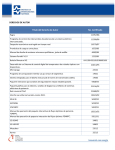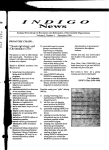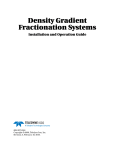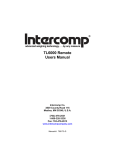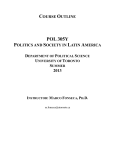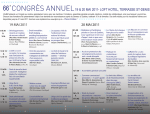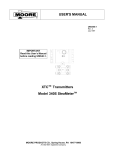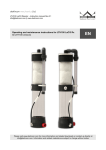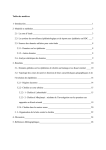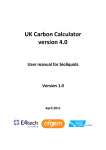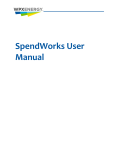Download the bdgeo software package: a multi
Transcript
Proceedings World Geothermal Congress 2000 Kyushu - Tohoku, Japan, May 28 - June 10, 2000 THE BDGEO SOFTWARE PACKAGE: A MULTI-TOOLBOX SYSTEM FOR STORAGE, VISUALIZATION AND ANALYSIS OF GEOTHERMAL DATA Eduardo R. Iglesias, Rodolfo J. Torres, Rosa M. Barragán, Víctor M. Arellano, Yalú Galicia and Pedro R. Mendoza Instituto de Investigaciones Eléctricas, Apartado Postal 1-475, 62001 Cuernavaca, Mor., México Key Words: geothermal software, reservoir assessment, databases, reservoir engineering, geochemistry. specialist's computers, to save system's resources. Thus, some users work only with the KERNEL, while others may work with the KERNEL plus one or more toolboxes, according to necessity. ABSTRACT There are four toolboxes (Fig. 1): (1) GEOQUIM performs standard geothermal geochemical computations; (2) an expert system called ANAPPRES that performs automatic analysis of pressure well tests; (3) GEOSIM, a numerical simulator of mass, energy and momentum flow in geothermal wellbores; and (4) ANPROD, an expert system for analysis of geothermal production data, aimed at diagnosing well/reservoir performance (under construction at the time of this writing, not described in this paper). BDGEO v4.0 is a user-friendly, integrated Windows 95/98/NT software package, set up as a distributed, client-server application over a local area network. Its main goal is to standardize and simplify the assessment and management of geothermal fields at departmental level. Extensive use of BDGEO by the technical staff of IIE's Geothermal Unit demonstrated its main virtues: it saves untold man-hours by automatically routing data between different applications (databases, computing algorithms, visualization tools); it keeps the Institution's geothermal databases in one place and homogeneously updated; and it dramatically improves the Institution's perception of its data resources. BDGEO v4.0 is written in Visual Basic (user interface, communications with Control Module and databases) and MATLAB (computations, visualization). The Access97 database management system is used for the Database Module. Multiuser versions of MATLAB and Access97 are installed in the network server, for user's convenience. In our standard setup the databases reside in the server, though it is possible to install them in another network drive. Depending on individually available hardware and software resources, each user may choose to install Access97 and/or MATLAB in his local drives or in a network drive. 1. INTRODUCTION Over the last few years we developed and tested the BDGEO V4.0 software package, within the context of the IEA's Geothermal Implementing Agreement, Annex IV, Deep Geothermal Resources. Our main goal is to standardize and simplify the assessment and management of geothermal fields at the departmental level. This is accomplished by providing all users with common databases and standardized toolboxes for visualization and analysis, that retrieve and format data transparently to the user. There is one Administrator of the System, with the usual privileges, and a few Discipline Specialists with privileges to update the databases. General Users cannot update the databases. Different password levels, used for these categories, are assigned by the Administrator. Access to BDGEO is restricted by these passwords. 2. ARCHITECTURE OF BDGEO V4.0 BDGEO's architecture is modular (Fig. 1). A Control Module, accessible to all users, interacts with a number of structurally identical databases, each belonging to a distinct geothermal field, and with several Application Modules. All Application Modules retrieve the necessary data from the corresponding database, automatically and transparently to the user. 2.1 The KERNEL As mentioned, the KERNEL includes the Control Module, the Database Module and the Visualization Module. These modules are described in some detail in Iglesias et al (1997). Due to space limitations here we describe them briefly. The main modules, collectively denominated KERNEL, are the Control Module, the Database Module and the Visualization Module. The KERNEL is installed in the server and in all the networked computers and implements the BDGEO v4.0 computing environment (Fig. 2). The environment's user interface is in Spanish. Control Module Figure 3 presents the main screen of the Control Module. The top menu reads (left to right) Applications, Configure and Help. As shown, selecting Applications presents options (top to bottom) Database, Visualization, GeoQuim, Anappres, GeoSim and Exit. These options correspond to the Application Modules and are displayed Independent Application Modules, called toolboxes, implement standard computations or tools for specialized analysis. Toolboxes are meant to be installed mostly in 4043 Iglesias et al. according to the toolboxes that have been installed in the particular system running BDGEO. Database Relationships presents a graphical depiction of the tables, fields and relationships of the databases. This is useful mostly to the database administrators. Choosing Database allows (top to bottom) Select Active Database, Access Active Database and Create New Database. Selecting the top option displays a list of the existing databases, to select from. The name and path of the active database are shown in the bottom panel (H:\ Directorio de BDs\cprieto97.mdb, in this case). Data manipulation and visualization is always performed on the active database. Users may select another database anytime. Selecting the bottom option allows one to automatically create and name a new database, with our standard structure, for another geothermal field. Selecting the middle option opens the Database Access Module, as described in the next subsection. Visualization Module BDGEO 4.0 offers visualization tools tailored for assessment and management of geothermal fields. Figure 4 presents one of its main screens with the Specialized Graphs option selected. Users navigate through layered menus like this, selecting the type of graph and the data to be visualized. Then, selection of the button Visualize triggers the corresponding query to the active database (transparent to the user) followed by screen visualization. Graph parameters (colors, lines, symbols, scales, legends, etc.) may be customized. When appropriate, users may select curve fitting for their data. All graphs may be printed. The option Configure in the top menu allows users to: (a) set default values for visualization parameters, such as line (solid, dashed, etc.), symbol, color, legends, etc.; and (b) to configure the drive:\path in which the databases, MATLAB and Access97 are installed (see section 2). Visualization is organized according to (see Fig. 4): General Graphs (Gráficas generales) and Specialized Graphs (Gráficas especializadas). General Graphs offers the following types of graphs: variable vs. time, variable vs. variable, Schoeller diagrams, triangular diagrams, contours, profiles (variable vs. depth or elevation), and lithological column. Database Access Module It offers the following functions: Forms, Reports, Queries, Database Maintenance and Database Relationships. Forms presents ad-hoc screens for updating or consulting data. Only authorized users can update data: a password is required. These screens are designed for efficient manual uploading of data. Furthermore, the screens resemble the paper data sheets provided by the originating field/laboratory. Data that is already in some form of computer file may be imported via MS Access tools. Specialized Graphs is organized into four disciplines. These are (see Fig. 4, under Especialidades): Reservoir Engineering (Ing. Yacimientos), Geochemistry (Geoquímica), Geology (Geología) and Drilling (Perforación). Within Reservoir Engineering, three general types of graphs are offered (Fig. 4, under "Areas de ING. DE YACIMIENTOS"): Production (Producción), Output Curves (Desarrollos) and Pressure Well Tests (Pruebas de presión). In Production users can select (Fig. 4, under "Tipo de Gráfica", top to bottom) Variable vs. Time, Variable vs. Variable, Contours and Saturation Curves. Saturation Curves are graphs of either log(pressure) or log(temperature) vs. specific enthalpy, which incorporate the bell-shaped saturation curves and lines of equal steam quality. In Output Curves users can select to plot liquid flowrate, steam flowrate, discharge flowrate, wellhead pressure, and specific enthalpy of the discharge vs. each other. In Well Tests users may plot: flowrate and pressure vs. time, pressure vs. log[(t+∆t)/∆t], and p or ∆p vs. ∆t. Reports offers three types of report: (i) for all the wells in the active database, (ii) for one well, and (iii) for a date interval in one well. Choosing one of these options opens a dialog box to select one of the pre-defined standard reports. Depending on the selected report, other dialog boxes appear as necessary to choose relevant parameters that define it. All reports may be printed, sent to an MS Excel file for analysis or to MS Word for publication, via standard MS Access tools. Queries provides access to the standard queries created to build the standard reports, and to other queries designed and saved by users. Dialog boxes similar to those described for the Reports function appear in the screen when selecting Queries. Executing a query shows the required data on screen. Within Geochemistry one may chose to plot Variable vs. Time, Variable vs. Variable, Contours, Triangular diagrams based on anions or on cations, Schoeller diagrams and FT vs. HSH (Gases grid) diagrams. Variables include chemical concentrations in the liquid and steam discharges, concentrations of stable isotopes, temperatures, enthalpies, etc. Database Maintenance: This function is only for database administrators. A password is required to access it. It provides the MS Access tools for modifying the components of the databases and its relationships. Within Geology users may opt to visualize Lithological 4044 Iglesias et al. column, Distribution of minerals (%), Hydrothermal alteration log, Texture log, and Homogeneization temperature log. These graphs present variables vs. depth. Users are allowed to select depth ranges for presentation. In Distribution of minerals (%) users must chose mineral types among Essentials, Accessories, Primary opaque, Secondary transparent, and Neoformed. Each type is presented in a separated graph. Users then have to select which of the existing minerals in the chosen depth interval to present in that graph. Logs of the selected existing minerals are presented side by side for the chosen depth interval (Fig. 5). offered only the first two options just mentioned. Finally, when selecting fed by "superheated steam", users are presented five choices: TD (D'Amore and Panichi, 1980), TCO2 (Arnorsson, 1985), TH2S (Arnorsson, 1985), TH2 (Arnorsson, 1985) and TFT (Fischer-Tropsch; Arnorsson,1985). The results may be displayed in the screen, saved to a file, printed in a report or plotted. (iii) Provides a comprehensive set of gas geothermometers: D'Amore and Panichi's (1980) and five gas geothermometers from Arnorsson and Gunlaugsson (1985), TCO2, TH2S, TH2, TCO2/H2 and TH2S/H2. Results may be displayed in the screen, saved to a file or printed. They are presented by sample date and geothermometer. Within Drilling six types of graphs are offered. These are: Lost circulation log, Lithology log, Well completion, Temperature log, Pressure log and Heating rate log. In Well completion one may select which of the recorded completions (e.g., the original one, the one after the first recompletion, etc.) to visualize. Heating rate logs are automatically computed from sequences of temperature logs obtained during the heating stage of the well. Users must select which of the available logs to include in the computations. (iv) It is designed to compute a comprehensive set of liquid phase geothermometers. The silica geothermometer (Fournier and Potter, 1982); the Cationic Composition Geothermoemeter (Nieva and Nieva, 1987); and four Na-K geothermometers: Na/K (Truesdell, 1975), Na/K (Fournier, 1979), Na-K-Ca (Fournier and Truesdell, 1973) and Na-KCa corrected by Mg (Fournier and Potter, 1979). Results may be presented in the screen, saved to a file, printed or plotted. 2.2 The GEOQUIM toolbox 2.3 The ANAPPRES toolbox This toolbox is described in some detail in Iglesias et al (1998). Due to space limitations here we describe it briefly. This is an intelligent system for automatic analysis of pressure well test. Interference tests with any number of observation, active and dual wells with variable flowrates can be analyzed, as well as drawdown tests with variable flowrates. Previous versions of ANAPPRES were presented by Arellano et al. (1990a, 1990b, 1989). GEOQUIM performs four types of standard geochemical computations: (i) equilibrium distribution of species in the reservoir; (ii) Cl- concentration in total discharge and in reservoir liquid; (iii) gas geothermometers; and (iv) liquid phase geothemometers. Figure 4 presents ANAPPRES main screen. The active database is shown in the upper left window (cprieto97.mdb in this case). All the pressure test logs in the active database are automatically presented, either in the list of observation wells (left) or in that of the active wells (right). These show, from left to right, a column for selecting logs, the name of the well and the log's identifier. Dual logs, those with both pressure and flowrate records, are shown in both lists. The range of dates covered by the selected logs (those marked with an "X") is shown in two small windows below that displaying the active database. Changing the range of dates narrows, widens or displaces in time the lists of active and observation logs, to facilitate selection. Under each list is a button that presents detailed information about the selected well/log . Here users may review the corresponding data list or plot it (pressing the button under the list). (i) These computations are based on EQQYAC (Barragán and Nieva, 1989), a program that calculates the equilibrium distribution of inorganic aqueous ion species in geothermal reservoirs from the chemical composition of discharged fluids and in situ physical measurements. The required reservoir temperature is automatically computed from the composition of the discharge, by means of a liquid phase geothermometer. For greater flexibility, we plan to add an option to assign a reservoir temperature, bypassing the geothermometer calculation. (ii) One may select to compute the Cl- concentration in total discharge and/or in the reservoir. Users are asked whether the well is fed by liquid, liquid and steam or superheated steam. Then they are presented with choices of relevant geothermometers to compute deep temperatures, depending on how the well is fed. Selecting "liquid" elicits three options: Cationic Composition Geothermometer (Nieva and Nieva, 1987), Na-K-Ca (Fournier and Truesdell, 1973) or silica (Fournier and Potter, 1982). If fed by "liquid and steam" users are Clicking the button in the lower right of the main screen runs the expert system. First the system searches for interference between wells and computes the corresponding values of transmissivity and storativity, by 4045 Iglesias et al. fitting a model to the data with a given tolerance for a χ2 statistic. Then it finds the boundaries, if any (Fig. 5). Finally, the system determines the boundary types (closed, constant pressure) and their locations, if there are enough data. By default, the results are presented in tables with comments (Fig. 5). Each card in the screen of Fig. 5 corresponds to one of the three stages of the analysis just mentioned. One can also automatically generate a standard report in MS Word, clicking the option Informe (Fig. 5).The relative locations of the wells, with or without lines between wells indicating interference may be plotted, clicking the buttons Graf. de interferencia and Graf. ubicación pozos, respectively. Clicking on Graf. de comparación brings about a figure comparing the measured and computed pressures versus time. pressure, liquid and steam flowrates and wellhead enthalpy are automatically shown in the table inmediatly below these windows. Below the table, the Input data (Datos de entrada) box shows data at inlet (top to bottom): mass flowrate, pressure, temperature, steam/water ratio and enthalpy. The boxes marked "Temperatura" (Temperature) and Presión (Pressure) are used when selecting output curves or well logs for input. The Description of piping (Descripción de tuberías, Fig. 8) card also allows data input either manually or automatically from the selected database. Manual input overrides automatic input. From left to right the variables on the table are: flow path length at beginning of segment, tubing ID, casing ID, tubing wall thickness, overall heat transfer coefficient, inclination of segment from vertical, type of flow (0=tubing, 1=annulus), rock temperature at HTCH. 2.4 The GEOSIM toolbox This is a gheothermal wellbore flow numerical simulator. The mathematical model is based on Gould's (1981) VSTEAM program. The Well and flow conditions (Condiciones del pozo y flujo) card (not shown) allows selection of the following parameters/choices: number of wellbore geometry segments, number of radial blocks in the reservoir, flow direction (up or down), compute pressure from top to bottom or viceversa, include the kinetic energy term in the calculations, use slip/non-slip density. Users must indicate whether to compute pressure/quality profiles or well deliverability. Three types of heat transfer may be selected: Ramey's (analytic), Willhite's annular or transient. There are also the following selections for vertical two-phase correlations: Hgedorn and Brown, Orkiszewski, Aziz and Govier, Beggs and Brill and Mukeherjee and Brill. Figure 6 presents GEOSIM's main screen. The menu bar offers, from left to right: Run, Reports, Exit and Help. The Reports option allows user to open and edit preformatted reports that GEOSIM generates automatically in MS Word. The remaining options are self-explanatory. The lower left button allows selection of the active database. The path to the selected database is shown in the lower middle window (H:\Directorio de Bds\chipila97.mdb in this case). The middle button (Terminar) exits the toolbox. The right button (Ejecutar >>) runs the simulator. The Case conditions (Condiciones del caso) card (not shown) inputs the following parameters: flow length, rock temperature at surface, rock temperature at bottom, pipe roughness, heat transfer coefficient from fluid to outer cement, diameter of outside cement, flowing time for heat transfer, reservoir heat transfer coefficient, thermal diffusivity and exterior radius for reservoir calculations. As shown in Fig. 6, there are six "cards" in this screen. They are used to input the necessary data and choose several computational options. In the first card, Initial options (Opciones iniciales), users may write a case description, comments, etc., that will be automatically incorporated in the report, in the upper left window. They can also choose whether to include the input data, a summary of the heat balance, the variables used to compute the pressure traverse or intermediate results, in the report. These selections are made by ticking the corresponding boxes in the card's lower right box (Opciones del reporte). Users may also choose which flow regime map and steam tables to use for the computations Ross-Griffith or Aziz. Default values are provided. The Fluid properties (Propiedades del fluido) card (not shown) inputs: solution gas/liquid ratio, solution gas gravity, water gravity, steam viscosity factor, water viscosity factor, steam/water critical pressure, steam/water critical temperature and steam water surface tension. Default values are provided. 3. CONCLUSIONS The Input data (Datos de entrada) card (Fig. 7) lets users input data either manually or by automatically querying the active database. One may select data from production logs, output curves or well-logs (upper left window "Datos de:"). Wells are selected from a list in the next window to the right (Pozo:). The date of the particular log is selected in the next window to the right (Fecha:). Wellhead Extensive use of BDGEO by the technical staff of IIE's Geothermal Unit demonstrated its main virtues: it saves untold man-hours by automatically routing data between different applications (databases, computing algorithms, visualization tools); it keeps the Institution's geothermal databases in one place and homogeneously updated; and it dramatically improves the Institution's perception of its 4046 Iglesias et al. Arellano, V.M. and Mendoza, P.(1997) BDGEO 4.0: An efficient system for assessment and management of geothermal fields. G.R.C. Transactions, Vol. 21, pp. 277281 data resources. ACKNOWLEDGMENTS This work was performed under contract to Mexico's Secretary of Energy. Iglesias, E.R., Barragán, R.M., Galicia, Y. and Torres, R.J. (1998) GEOQUIM: A comprehensive geochemical toolbox for the BDGEO software package. Proc. 20th New Zealand Geothermal Workshop, pp. 227-231 REFERENCES Arellano, V.M., Iglesias, E.R., Arellano, J. and Pérez, M. (1990a) ANAPPRES v3.0: Automatic interference -test analysis in personal computers, G.R.C. Transactions, Vol. 14, pp.1271-1278 Nieva D. and Nieva R. (1987) Developments in geothermal energy in M'exico - Part Twelve. A cationic geothermometer for prospecting of geothermal resources, Heat Recovery Systems & CHP, Vol. 7(3), 243-258. Arellano, V.M., Iglesias, E.R. and Arellano, J. (1990b) ANAPPRES v2.0: A computerized expert system for welltest analysis, Computers and Geosciences, Vol.16, No. 8, pp.1105-1115 Truesdell A.H. (1975) Summary of section III geochemical techniques in exploration, Proceedings, Second U.N. Symp. on the Development and Use of Geothermal Resources, San Francisco, Vol. 1, liii-lxiii. Arellano, V.M., Iglesias, E.R. and Arellano, J. and Schwarzblat, M. (1989) Developments in geothermal energy in Mexico - Part twenty-one. ANAPPRES v1.0: A computerized expert system for interference-test analysis in geothermal reservoirs, Heat Recovery Systems & CHP, Vol. 9. pp.101-113 DB1 Arnórsson S. and Gunnlaugsson E. (1985) New gas geothermometeres for geothermal exploration - Calibration and application, Geochim. Cosmochim. Acta, Vol. 49, 1307-1325. DB2 DB3 DBn KERNEL DATABASE ACCESS MODULE Barragán R.M. and Nieva D. (1989) EQQYAC: program for determining geothermal reservoir chemical equilibrium, Computers & Geosciences, Vol. 15(8), 12211240. GEOQUIM CONTROL MODULE ANAPPRES VISUALIZATION MODULE GEOSIM ANPROD Fig. 1. Architecture of BDGEO D'Amore F. and Panichi C. (1980) Evaluation of deep temperatures in hydrothermal systems by a new gas geothermometer, Geochim. Cosmochim. Acta, Vol. 44, 549-556. Fournier R.O. and Potter R.W. (1979) Magnesium correction to the Na-K-Ca chemical geothermometer, Geochim. Cosmochim. Acta, Vol. 46, 1969-1974. Fournier R.O. and Potter R.W. (1982) A revised and expanded silica (quartz) geothermometer, Geothermal Resources Council Bulletin, Vol. 11, 3-9. Founier R.O and Truesdell A.H. (1973) An empirical NaK-Ca geothermometer for natural waters, Geochim. Cosmochim. Acta, Vol. 37, 1255-1275. Fig. 2. Sketch of BDGEO's local area network at IIE Gould T.L. (1981) Steam -water flow in wells with heat transfer VSTEAM, User's Manual, Intercomp. Iglesias, E.R., Torres, R.J., Galicia, Y., Barragán, R.M., 4047 Iglesias et al. Fig. 3. The main screen of the Control Module. Fig. 6. Main screen of GEOSIM Fig. 7. GEOSIM's Input data card Fig. 4. Main screen of ANAPPRESS Fig. 5. Results of a search for boundaries ANAPPRES in Fig. 8. GEOSIM's Description of piping card 4048






